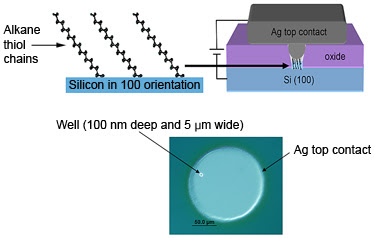
Side and top views of the NIST molecular resistor. Above are schematics showing a cross-section of the full device and a close-up view of the molecular monolayer attached to the CMOS-compatible silicon substrate. Below is a photomicrograph looking down on an assembled resistor indicating the location of the well.
The ability to use a silicon crystal substrate that is compatible with the industry-standard CMOS (complementary metal oxide semiconductor) manufacturing technology paves the way for hybrid CMOS-molecular device circuitry—the necessary precursor to a “beyond CMOS” totally molecular technology—to be fabricated in the near future.
For their electronic device, the NIST team first demonstrated that a good quality monolayer of organic molecules could be assembled on the silicon orientation common to industrial CMOS fabrication, verifying this with extensive spectroscopic analysis.
They then went on to build a simple but working molecular electronic device—a resistor—using the same techniques. A single layer of simple chains of carbon atoms tethered on their ends with sulfur atoms were deposited in tiny 100-nanometer deep wells on the silicon substrate and capped with a layer of silver to form the top electrical contact. The use of silver is a departure from other molecular electronic studies where gold or aluminum has been used. Unlike the latter two elements, silver does not displace the monolayer or impede its ability to function.
The NIST team fabricated two molecular electronic devices, each with a different length of carbon chain populating the monolayer. Both devices successfully resisted electrical flow with the one possessing longer chains having the greater resistance as expected. A control device lacking the monolayer showed less resistance, proving that the other two units did function as nonlinear resistors.
The next step, the team reports, is to fabricate a CMOS-molecular hybrid circuit to show that molecular electronic components can work in harmony with current microelectronics technologies.
This work was funded in part by the NIST Office of Microelectronics Programs and the Defense Advanced Research Projects Agency (DARPA) MoleApps Program.

Brian Wang is a Futurist Thought Leader and a popular Science blogger with 1 million readers per month. His blog Nextbigfuture.com is ranked #1 Science News Blog. It covers many disruptive technology and trends including Space, Robotics, Artificial Intelligence, Medicine, Anti-aging Biotechnology, and Nanotechnology.
Known for identifying cutting edge technologies, he is currently a Co-Founder of a startup and fundraiser for high potential early-stage companies. He is the Head of Research for Allocations for deep technology investments and an Angel Investor at Space Angels.
A frequent speaker at corporations, he has been a TEDx speaker, a Singularity University speaker and guest at numerous interviews for radio and podcasts. He is open to public speaking and advising engagements.

